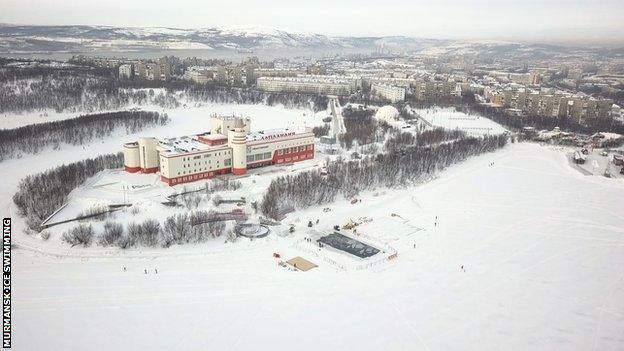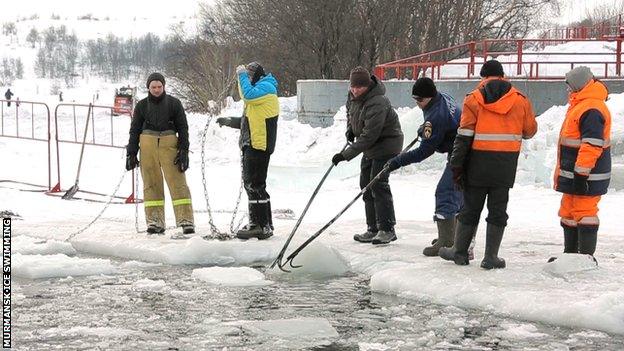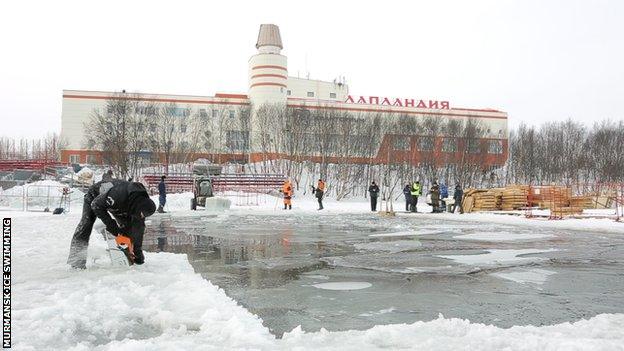2019 World International Ice Swimming Championships: What it takes to prepare for a sub-zero swim
- Published
Team GB are about to compete in the Ice Swimming World Championships
"Sometimes I get in and I think 'gosh, this feels horrible'," says champion ice swimmer Jade Perry.
This isn't just your average test of physical endurance.
Taking a dip in sub-zero temperatures is already unappealing, without the prospect of doing it in a makeshift pool carved out of a frozen lake at the height of Russian winter.
This week, 400 swimmers from 34 countries will travel to Murmansk, Russia, for the 2019 World International Ice Swimming Championships, external.
British Swimming is sending a 15-strong team to take part.
One of the audacious athletes is 36-year-old Jade Perry, who is hoping for success in sub-zero temperatures.
What is ice swimming?

Competitors will swim 40 lengths of the ice pool
For those of us more familiar with warmer waters, ice swimming - a new discipline in open-water swimming introduced in 2009 - involves competitors swimming in 5C or colder water, in outside air temperatures of between -14C and -20C: colder than a household freezer.
This year's championships, which get under way on Thursday and are organised by the International Ice Swimming Association (IISA), will see competitors braving frosty temperatures in a 25-metre pool in Lake Semyonovskoye, carved out of the ice with a chainsaw.
No wetsuits or extra layers are allowed. Instead, participants must wear only approved standard swimwear, goggles and a swimming cap.
Risks of a dip, external in cold water include hypothermia, cold shock, asthma and 'afterdrop', which brings on excessive shivering, external as the body's core temperature warms up again after exiting the water.
The swimmers will access the water via ladders; plunging or jumping in results in instant disqualification due to the extreme dangers associated with suddenly throwing your body into such low temperatures.
"There are associated health risks with every sport," said open water swimming coach Leon Fryer.
"Winter swimming is carefully controlled with safety and recovery teams on site minimising these risks. There are actually more deaths attributed to cyclists and runners falling into cold water than swimmers drowning.
"There is also a lot of anecdotal evidence that cold water swimming is good for the brown fats around the heart and for easing depression and poor mental health."
On the agenda for brave competitors this week are events such as the ice kilometre, ice mile, 1,000m freestyle, 500m freestyle and the 100m breaststroke.
What is the appeal?

Ice swimmers face sub-zero temperatures
Perry is the British women's record holder for the fastest 1km ice swim. Speaking to BBC's Good Morning Scotland about her love of the sport, she said: "I ask myself that [why I do it] quite a lot, trust me.
"It's fantastic when you get in the water - you're just free. You're not worrying about work, or about your house, or anything like that. You're in the water and you're just thinking about swimming.
"After you get over the initial gasping and the initial 'wow, this feels cold', it's actually just wonderful.
"I've been doing this since 2014 and sometimes I get in and I think 'gosh, this feels horrible'.
"It takes years and years of building it up slowly, sometimes just going in for three, four or five minutes and now I can be in for 20, 22, 25 minutes in quite cold water.
"It's an eight-lane swimming pool that's carved out of the ice with a chainsaw - it's 40 lengths of that pool.
Asked what makes the average person make the transition from swimming pool to ice pool, Perry said: "I was asked to swim in a charity relay to swim across the English Channel, so that was it - I gave up the wetsuit, I started swimming through winter, I did a couple of competitions.
"I've always been a swimmer, since I was very young, but competitive and not open water. So I started doing some cold water competitions and it just grew from there."
Perry is set to compete in the women's ice kilometre race, 50m front crawl and in the 4x250m country relay.
What does the training involve?

The 25-metre pool is carved out of the ice on Lake Semyonovskoye with a chainsaw
The lochs of Scotland proved to be a decisive factor in Perry moving from her Essex home, allowing for more frequent training sessions.
"Even Scotland's not getting down to Russian temperatures," she said.
"I was up at a loch at the weekend where the water was about 3.8C, the air was 1C, we had the snow coming down - and that was a fantastic training session.
"I know a lot of the British team who are based in England and aren't quite as fortunate with the weather are having nightly ice baths.
"We are rigorously medically checked, we have to have ECGs [electrocardiograms] and various medical tests the day before we go. And there has to be a spotter there who knows your stroke and to highlight if there are any issues.
"When you get out there's quite a thorough warming-up process set up to make sure the swimmers recover well."
What next for the sport?
IISA are now keen to fight for the inclusion of ice swimming as a category in the 2022 Winter Olympics, as well as making it an internationally-recognised sport.
"Ram Barkai, the founder of IISA, had a dream to establish ice swimming into the Winter Olympics when he established the group in 2009," coach Fryer said.
Fryer added that some 315 people around the world have completed the ice mile, with 104 of those from the UK.
"It is our hope that Fina (International Swimming Federation) will see the huge popularity and growth in winter swimming and get behind the call to include ice swimming in the 2022 Olympics.
"With over 400 swimmers from 34 countries competing this week, we hope Murmansk will showcase just how exciting an addition to the Olympic schedule winter swimming will be."
The 2019 World International Ice Swimming Championships takes place 14-18 March.